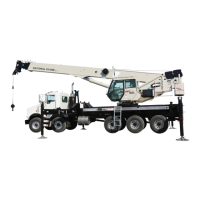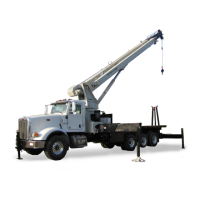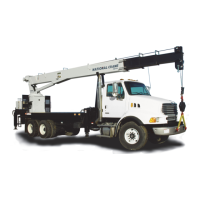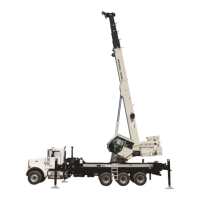6-4 Published 4-23-2018 Control # 239-11
MAINTENANCE CHECKLIST NBT40 SERIES OPERATOR MANUAL
Dynamic Shock Loads
Subjecting wire rope to abnormal loads beyond the
endurance limit will shorten the wire rope life expectancy.
Examples of this type of loading are listed below.
• High velocity movement, for example; hoisting or
swinging of a load followed by abrupt stops.
• Suspending loads while traveling over irregular surfaces
such as railroad tracks, potholes, and rough terrain.
• Lifting a load that is beyond the rated capacity of the
lifting mechanism, such as overloading.
Precautions and Recommendations During
Inspection
• Always use safety glasses for eye protection.
• Wear protective clothing, gloves, and safety shoes as
appropriate.
• Measure the rope’s diameter across crowns of the
strands when determining if rope has become damaged,
refer to Figure 6-1.
Inspection
All hoist cable in service needs to be inspected on a daily,
monthly, and quarterly basis. Cable which has been idle for a
period of a month or more must be given a thorough
inspection before it is placed in service. These inspections
should cover all types of deterioration including:
• Distortion such as kinking, crushing, un-stranding, bird
caging, main strand displacement or core protrusion.
• Loss of cable diameter in a short cable length or
unevenness of outer strands indicates the cable needs
to be replaced.
• Significant corrosion.
• Broken or cut strands.
• Number, distribution and type of visible broken wires.
• Core failure in rotation resistant ropes.
• Prior electrical contact with a power line or other electric
arc damage.
• Significantly corroded, cracked, bent, or worn end
connections.
Only inspect the outer surface of a cable. Never attempt to
open the cable.
Pay particular attention to areas of the rope where wear and
other damage is likely to occur:
• Pick-up Points: Sections of wire rope that are repeatedly
stressed during each lift, such as those sections in
contact with sheaves.
• End Attachments: The point where a fitting is attached to
the wire rope or the point where the wire rope is attached
to the hoist drum.
• Abuse Points: The point where the wire rope is
subjected to abnormal scuffing and scraping.
Daily Inspections
All cable in continuous service must be inspected at the
beginning of each work day. Inspect the eye end and length
of cable that is used in daily operation. The end should be
inspected for abrasion, corrosion, broken wires, and loose or
broken servings. Inspect the remainder of the cable length
used for daily operations for points showing kinks, sharp
bends, or any other evidences of damage or excessive wear.
Monthly Inspections
Inspect the eye end and length of cable normally used in
daily operations. Examine the rest of the cable for kinked,
crushed or otherwise damaged points.
Periodic Inspections
Wire rope should be inspected periodically/annually, or at a
shorter time interval, if necessitated by environmental or
other adverse conditions, and shall cover the entire length of
the wire rope. Periodic inspection should include all previous
items listed under Inspection, plus the following:
• Inspect for severely corroded or broken wires at end
connections.
• Inspect wire rope in areas subjected to rapid
deterioration such as:
- Sections in contact with saddles, equalizer sheaves,
or other sheaves where wire rope travel is limited.
- Sections of wire rope at or near terminal ends where
corroded or broken wires may protrude.
• Inspect boom nose sheaves, hook block sheaves, boom
extension/extension sheaves, auxiliary boom nose
sheaves, and hoist drums for wear. Damaged sheaves
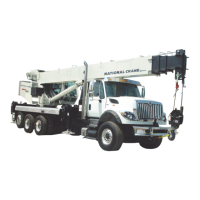
